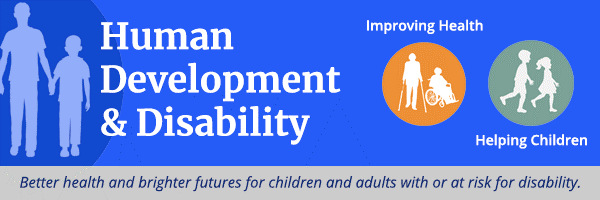DHDD Newsletter – August 2018

In a recent trip to Brazil, I was able to share findings from our Zika Outcomes and Development in Infants and Children (ZODIAC) project. This project reminded me of the importance of collaboration and partnerships to achieve our mission. Everyone has something unique to bring to the table, and inspires and motivates each other. DHDD is so proud of the work we do together!
– Dr. Georgina Peacock, Director, DHDD
dhdddirector@cdc.gov
Disability Prevalence and Health Care Access

DHDD’s Disability and Health Branch published a new report in CDC’s Morbidity and Mortality Weekly Report (MMWR) that shows 1 in 4 adults, or 61 million people, has a disability. This is the first time CDC could analyze and report on all six functional disability types (vision, hearing, cognition, independent living, mobility, and self-care) using 2016 Behavioral Risk Factor Surveillance System data.
The report shows that 1 in 7 adults reported the most common disability type, mobility (defined as serious difficulty walking or climbing stairs). Disability-specific challenges in accessing healthcare are common, particularly among young and middle-aged adults.
Research on the number of people with disabilities, their characteristics, and their disability-specific differences in health care access might enable health care professionals to address barriers to health care, ensure inclusive health programs, and improve the health of people with disabilities. On August 27, we will post a feature that includes information that healthcare providers can use to improve accessibility and inclusion.
Back-to-School Emergency Preparedness
As students head back to school this time of year, it’s important to understand how a teacher plays an important role in preparing for and helping children recover from a public health emergency. DHDD’s Child Preparedness Unit (CPU) co-wrote a CDC feature with CDC’s Office of Public Health and Preparedness Response that includes tips for teachers and caregivers on helping students cope after a disaster.
September is National Preparedness Month, so be on the lookout for more resources and information from the CPU!

Thank you, Julie Bolen!

This summer, DHDD celebrated Dr. Julie Bolen as she retired from her position as the lead of the Rare Disorders and Health Outcomes team. Her work on DHDD’s fragile X, muscular dystrophy, and spina bifida projects was substantial during the more than 8 years that she spent with us (and over 30 years total at CDC!). We are grateful to have had her as a part of the team! Good luck and have a happy retirement, Julie!
Dr. Coleen Boyle, the Director of the National Center on Birth Defects and Developmental Disabilities at CDC, also presented former First Lady Rosalynn Carter with a gift


